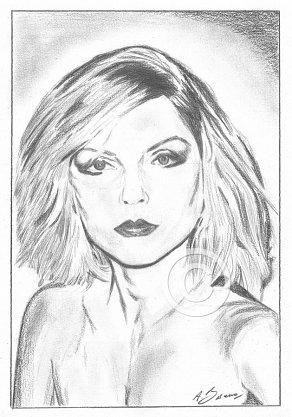Debbie Harry
Pencil Portrait by Antonio Bosano.

Shopping Basket
The quality of the prints are at a much higher level compared to the image shown on the left.
Order
A3 Pencil Print-Price £45.00-Purchase
A4 Pencil Print-Price £30.00-Purchase
*Limited edition run of 250 prints only*
All Pencil Prints are printed on the finest Bockingford Somerset Velvet 255 gsm paper.
P&P is not included in the above prices.

Recommended listening
Parallel Lines (1978)
New Wave’s big pop breakthrough, ‘Parallel Lines’ is a perfect synthesis of raw punk edge, Sixties-pop smarts and downtown-New York glamour. Debbie Harry created a new kind of rock & roll sex appeal that brought New York demimonde style to the mainstream. Madonna was surely watching.
One of the biggest hits of 1978/9, the album reached saturation point on international airwaves with each subsequent single ‘pull’ – “Sunday Girl” and the disco-pastiche turned disco-classic “Heart Of Glass” (both UK No. 1’s) as well as “Picture This” and “Hanging On The Telephone.”
Pop, as opposed to rock, implies vacuous, light hearted and disposable pap; to be enjoyed for the moment but ultimately consigned to the trash can. Blondie would redefine the genre – supremely assured, the group was unafraid to go disco, go art, or just play fine, fine pop.
A veteran in the business, Debbie Harry was street-wise, confident, and completely in control. Thirty three -but looking ten years younger – she was the visual lynchpin of a real band in which each member over-reached to achieve a, enduring product. Referencing all that was best in their 60s influences, whilst also embracing the New York punk scene that the group had grown out of, they would find an empathetic producer in Mike Chapman, selecting material which played to the group’s strengths. For sure, the “Heart of Glass” promo was a visually creaming experience for every young – and not so young – guy, but Harry had much more to offer than simply sex.
‘Parallel Lines,’ with its iconic cover imagery, would be a permanent fixture in Britain in the late 70s. It went to No. 1 in the chart on 17th February and remained there for four weeks, staying on the listings for 106 weeks in total.
Desert Island Discs - BBC Radio 4 (22/5/11)
Recommended reading
Chris Stein /Negative : "Me, Blondie, and the advent of Punk." (2014)
In the 70’s, aspiring punk-pop star Debbie Harry had a photographer on hand to chronicle her every move – her friend, bandmate and lover Chris Stein.
Long after we have forgotten Cheryl Tiegs, Marisa Berenson and other supermodeld of the era, we will remember Debbie Harry for her Bardot mouth, and those remarkable cheekbones. Her glam-punk aestetic still feels contemporary, and Stein’s photographic album recaptures her iconic period.
Harry first saw Stein from the stage, in 1974, while she was singing in a girl group called the Stilettos. He was silhouetted in the crowd and, at the time a nervous performer, she directed the songs to him. They met after the show and the rest is pop history: they became an item, began writing songs together and Blondie, a pop band born out of a punk spirit, went on to have hit after hit, while retaining the scrappy insouciance that defined downtown New York in the 1970s. Songs such as Call Me, Heart of Glass and Atomic have attained a kind of indelibility: the power of Harry and Stein’s musical partnership is obvious. Less well known is the kind of chemistry they have as photographer and subject.
When they started to tour in 1977, they quickly gained a reputation as a band to watch and some of their early fans were David Bowie and Iggy Pop.
Stein’s photographs range from the early New York days where he captures some of the rundown New York areas that were often the crucible for creative enterprises, to life on the road where he often captures for posterity bands and singers at various stages of their success.
Stein has no favourite picture of Harry. As with the band’s songs, “they’re all like movements in a larger piece. That’s how I think about it.”
Harry herself sees them as distinct from anyone else’s pictures of her.
“I definitely do not have that kind of intimacy with any other photographer,” she says, “and when I look at the pictures that he shot, I can see the difference in my eyes.” When pressed further on the subject, Harry will admit that the difference was love.
It’s an expensive purchase – production costs are invariably high with books of this nature – but Blondie die-hards will not be disappointed.
My own personal favourite is a shot of her in a salmon pink polo neck jumper and jeans, sitting by a window. Her hair is swept back at the sides, and there is an ethereal and vulnerable beauty about her, far removed from her on-stage persona. The photograph can be locatede at:


Comments
Interviewed on Radio 4’s ‘Desert Island Discs’ in 2011, Debbie Harry, then 65, was asked by the presenter Kirsty Young whether ageing troubled her.
Replying in the affirmative, the woman who fired a thousand male fantasies three decades earlier added that: “Oh yes, sure, it’s hard. Regardless of what I say about trying to be better at what I do, I rely on looks a lot. Women’s calling cards, unfortunately, are based on their looks. As far as ageing goes, it’s rough. I’m trying my best now. I’m healthy and I exercise like a fiend and do all that stuff that recovered drug addicts do.”
In her heyday, she looked like a woman unexpectedly roused from her love nest to sing onstage, her tousled hair, shirt, stilettos and little else, coalescing in an intoxicating vision of sheer womanhood. For my money, with her pop sensibilities still reassuringly on track, she’s still got ‘it’ in spades…